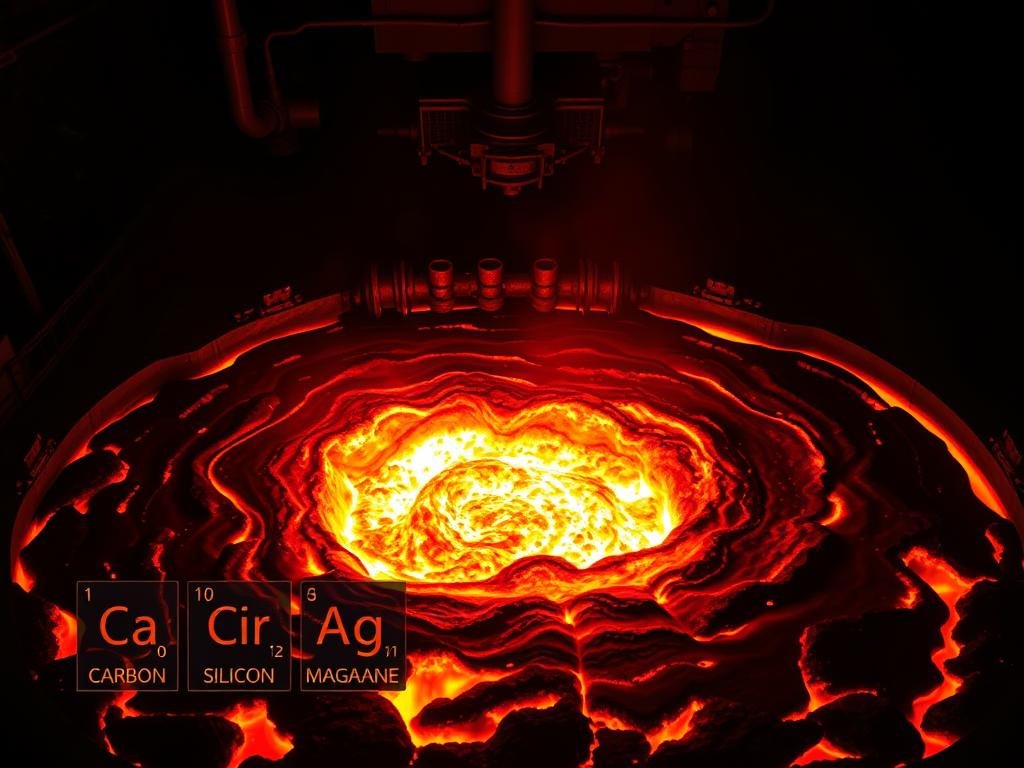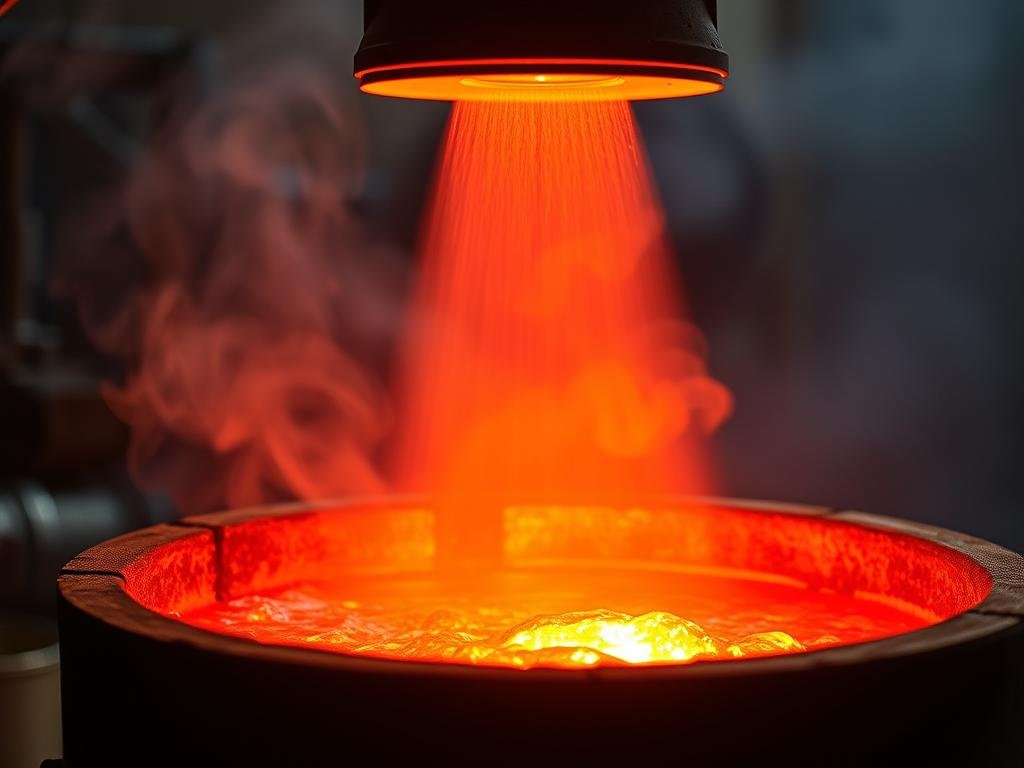The melting point of iron, 大約 1,538°C (2,800°F),是冶金和製造中的一個關鍵參數。這個基本特性影響著鐵在各行各業中的行為和應用,從建築到汽車。
At such a high 溫度, iron’s strong atomic bonds require significant energy to break, making it a vital component in the production of steel and other alloys. Understanding the 融化特性 鐵對於從事鐵基材料工作的工程師和冶金學家來說是必不可少的。
本文將探討鐵的熔化行為背後的科學、影響因素,以及其在各種工業應用中的重要性。
Understanding Iron’s Melting Point
Understanding the melting point of iron is essential for metallurgists and manufacturers alike. The melting point is a critical property that determines the usability of iron in various industrial applications.
What Is the Melting Point of Pure Iron?
Pure iron has a melting point of 1,538°C (2,800°F). This is a well-defined physical property that serves as a reference point for understanding the melting behavior of different iron alloys.
Melting Points of Different Types of Iron
不同類型的鐵由於成分的差異,展現出不同的熔點。例如,鑄鐵的熔點範圍顯著低於純鐵,約在 1,150-1,200°C (2,102-2,192°F)。 鐵藝, with its minimal carbon content, has a melting range of 1,482-1,593°C (2,700-2,900°F).
As noted by experts, “The presence of carbon and other alloying elements significantly affects the melting point of iron alloys.” Various types of cast iron, including gray, white, and ductile iron, have distinct melting ranges based on their specific composition and microstructure.
- Cast iron’s lower melting point makes it suitable for casting applications.
- Carbon steel, an alloy of iron, melts between 1,425-1,540°C (2,597-2,804°F), demonstrating the impact of carbon content on melting temperature.
Factors Affecting Iron’s Melting Point
The melting behavior of iron is impacted by several important considerations, including its purity, the presence of impurities, and the pressure conditions under which it is melted.
Purity and Composition
The purity and composition of iron significantly affect its melting point. Pure iron has a specific melting point, but variations in composition can alter this temperature.
Presence of Impurities
Impurities within iron can lower its melting point by introducing elements that have different melting behaviors, thus affecting the overall melting characteristics of the material.
Pressure Conditions
Pressure conditions also play a crucial role in determining iron’s melting point. At higher pressures, the melting point increases due to the need for more energy to overcome the increased atomic interactions.
| 因素 | 熔點的影響 | Relevance |
|---|---|---|
| Purity | Significant impact | 高 |
| 雜質 | 熔點較低 | 高 |
| 壓力 | 熔點升高 | 適度 |

Iron Melting Point in Manufacturing Processes
Understanding iron’s melting point is essential for optimizing manufacturing processes. The melting point influences various industrial applications, including casting, welding, forging, and heat treatment.
Casting Applications
In casting, iron is heated beyond its melting point to achieve a liquid state, allowing it to be poured into molds. The precise control of temperature is crucial to prevent defects and ensure the quality of the castings.
焊接注意事項
Welding involves joining iron parts by heating them to a high temperature, often approaching but not necessarily exceeding the melting point. The thermal management during welding is critical to prevent warping or weakening of the material.
Forging and Heat Treatment
Forging and heat treatment processes rely on heating iron to specific temperatures below its melting point. For instance, forging operations typically heat iron to between 900°C and 1,200°C, making it malleable. Heat treatment processes like annealing, quenching, and tempering also depend on precise temperature control relative to iron’s melting point.
| Process | 溫度範圍 (°C) | 目的 |
|---|---|---|
| 鍛造 | 900 – 1,200 | Shaping iron |
| 退火 | Approaching melting point | Relieve internal stresses |
| 滅火 | Near 900 | Create specific microstructures |
| 回火 | 150 – 650 | Balance hardness and toughness |
Methods for Melting Iron
To melt iron, various methods are employed, each with its advantages and specific applications. The choice of method depends on factors such as the type of iron, the desired purity of the molten metal, and the specific requirements of the manufacturing process.
Blast Furnace Technology
Blast furnaces are a traditional method for melt iron, using a mixture of iron ore, coke, and limestone. This process is energy-intensive but can produce large quantities of molten iron.
Electric Arc Furnaces
Electric arc furnaces (EAFs) are widely used for melting metal, including iron. EAFs use an electric arc to heat the metal, offering a more energy-efficient alternative to blast furnaces for certain applications.
Induction Furnaces
An induction furnace employs electromagnetic induction to heat iron in a crucible efficiently. Key benefits include:
- Precise temperature control relative to iron’s melting point, ideal for specialty alloys.
- Non-contact heating minimizes contamination, producing higher purity metal.
- 快速加熱降低能源消耗與氧化損失。
- 通過電磁力的溫和攪拌作用,形成均勻的熔融鐵。
| 融化方法 | 能源效率 | 純度控制 |
|---|---|---|
| 高爐 | 低 | 適度 |
| 電弧爐 | 適度 | 高 |
| 感應爐 | 高 | 非常高 |
比較鐵的熔點與其他金屬
鐵的熔點相較於其他金屬在冶金和材料科學中扮演著重要角色。這個比較對於了解鐵在各種應用中的適用性至關重要。
常用工業金屬
Industrial metals like nickel have melting points that are comparable or different from iron. For instance, nickel melts at 1,455°C, which is relatively close to iron’s melting point, making their alloys useful in certain applications.
貴金屬與特色金屬
貴金屬如金(1,064°C)和銀(961.8°C)具有明顯低於鐵的熔點。相較之下,特殊金屬如鎢(3,422°C)和鉬(2,623°C)具有更高的熔點,使它們非常適合高溫應用。正如一位冶金專家所指出的:「金屬的選擇通常取決於其熔點以及它與其他元素的相互作用。」
“金屬的性質,包括其熔點,在決定其在各種產業中的用途方面具有關鍵作用。”
This highlights the importance of comparing melting points to select the right metal for specific uses.
The Role of Carbon in Iron’s Melting Point
The presence of carbon in iron significantly influences its melting point, a crucial factor in metallurgical processes. This effect is particularly important in the production of steel and cast iron, where carbon content varies widely.
How Carbon Lowers Melting Temperature
碳通過形成鐵-碳合金來降低鐵的熔點。隨著碳含量增加,熔點降低。例如,純鐵的熔點為1,538°C,而含有2-41%碳的鑄鐵則在1,150-1,200°C之間熔化。

鋼與純鐵的熔點
Steel, an alloy of iron and carbon, has a melting point that varies with carbon content. Low-carbon steels melt around 1,500°C, while high-carbon steels melt between 1,380-1,430°C. This range is significantly lower than pure iron’s melting point, demonstrating carbon’s substantial influence on iron’s thermal behavior.
結論:鐵的熔點在現代工業中的重要性
作為一個基本特性,鐵的熔點對其在當代工業中的應用具有深遠的影響。
The melting point of iron, approximately 1,538°C (2,800°F), is a critical aspect of metal processing that influences various manufacturing techniques. From 鑄造與鍛造到焊接與熱處理, 知道這個關鍵屬性確保流程能高效且高品質地執行。
妥善管理熔點能夠生產出可靠且耐用的鐵基元件,這在許多工業應用中都至關重要。現代製造流程利用以鐵的熔點特性為校準的先進溫度控制系統,以確保鐵基產品的一致品質與性能。
鐵的熔點與其晶體結構之間的關係,仍然是一個持續研究的領域,這個領域有望帶來對這種古老但仍然至關重要的材料的新見解。隨著產業的不斷發展,對鐵的熔融行為的基本認識仍然是開發新材料和工藝的關鍵。
